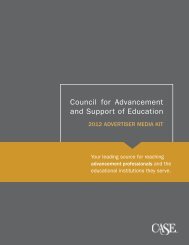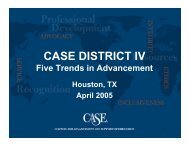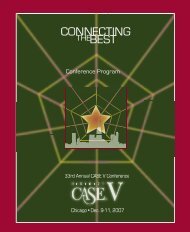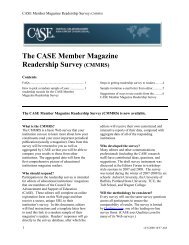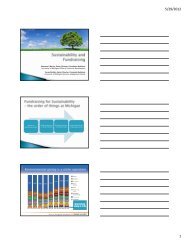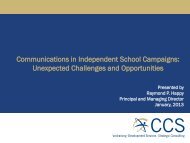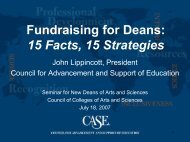Create successful ePaper yourself
Turn your PDF publications into a flip-book with our unique Google optimized e-Paper software.
comparing costs: endowment per<br />
student (and Mandatory Charges)<br />
really be great on the private institutions. You can raise tuition as<br />
much as you want, but nowadays you’re raising tuition and you’re<br />
compensating that raise with financial aid. There’s no net gain. The<br />
model will have to change.”<br />
Nugent anticipates change. “A part of me thinks the current<br />
system is not sustainable,” she said. “The current financial aid<br />
system implies a social contract, where the wealthy assume a greater<br />
share of the cost. And I think the social contract has broken down in<br />
recent years.”<br />
The financial aid system must be streamlined and simplified,<br />
Feldman said, starting with the Free Application for Federal Student<br />
Aid form. Beyond that, he envisions a sort of college-education<br />
Social Security program that begins on the front end. With a “public<br />
investment” by taxpayers, the government would establish a savings<br />
account for each child at birth, providing enough income for a basic<br />
college education at age eighteen. “The point would be that you<br />
would begin, from the earliest age, to change the entire expectations<br />
of a family,” he said.<br />
“The United States used to be the world leader in having an<br />
educated work force. Quite a number of countries have surpassed<br />
us. The rest of the world is<br />
not stupid. They see that<br />
the investment in education<br />
has a payoff.”<br />
The payoff can be<br />
tallied in more than a<br />
payday.<br />
“I think we devote too<br />
much attention to simply<br />
dollars,” Nugent said. “The<br />
ability to live a full life as<br />
a participant in society, as<br />
a person who can take a<br />
delight in the arts and in<br />
your cultural surroundings,<br />
a person capable<br />
of making judgments, a<br />
person with confidence—I think those are undoubtedly components<br />
of a good life. And, by and large, if you are ending your education at<br />
seventeen, you are probably not well equipped to enjoy those good<br />
things in your life.”<br />
Ronald K. Griggs, vice president for library and information<br />
services, finds the value of a <strong>Kenyon</strong> education in the classroom.<br />
“In every class you’re going to be exposed to something new. There’s<br />
not a dud in the bunch,” Griggs said. “That’s the richness of the<br />
environment.”<br />
What results is the “incredible confidence” that Griggs sees in the<br />
eyes of graduating seniors. “They can pretty much tackle anything.”<br />
Williams ....... $685,672 ($54,560)<br />
Grinnell ....... $649,517 ($49,144)<br />
Middlebury ... $286,991 ($53,420)<br />
Carleton ...... $261,929 ($54,180)<br />
Denison ........ $255,835 ($50,170)<br />
Bates ........... $103,518 ($55,300)<br />
<strong>Kenyon</strong> ......... $92,051 ($52,650)<br />
Making <strong>Kenyon</strong> Affordable:<br />
Financial Aid<br />
How do students and families expect<br />
to cope with the high cost of college?<br />
Short of winning a lottery, the answer<br />
is financial aid. It’s often the deciding<br />
factor in college choice. Cheyenne<br />
Cody Cardell ’15—a talented artist<br />
and outstanding student from New<br />
Mexico—chose <strong>Kenyon</strong> over Parsons<br />
Paris School of Art and Design (in France) and six<br />
other private schools because of <strong>Kenyon</strong>’s more<br />
generous financial aid offer. “Parsons offered her a<br />
great package, but it was not good enough,” said<br />
Ede Cardell, Cheyenne’s mother.<br />
<strong>Kenyon</strong> devoted 21.5 percent of its $102.9 million<br />
operating budget in 2010-11 to financial aid.<br />
About 60 percent of its students receive aid from<br />
the <strong>College</strong> and/or outside sources. At a time when<br />
federal and state support for higher education is<br />
falling, more students are qualifying for more aid.<br />
The average need-based grant per <strong>Kenyon</strong> student<br />
has been steadily increasing for more than a decade—and<br />
in 2009, in the wake of the September<br />
2008 economic collapse, it took a leap of $4,000.<br />
To meet increasing demand, <strong>Kenyon</strong> raised<br />
nearly $60 million in new endowment for financial<br />
aid during the recently completed campaign,<br />
doubling its financial-aid endowment. Campaign<br />
donors created sixty-seven new scholarship<br />
funds. But the sum still fell $11 million short of the<br />
campaign goal for endowed financial aid. “I was<br />
shocked that we didn’t reach that goal,” said<br />
Jennifer Delahunty, dean of admissions and<br />
financial aid. “We’re struggling to keep our commitments<br />
to students and families.”<br />
Financial aid is the lifeblood of the <strong>College</strong>,<br />
essential in attracting the best and brightest<br />
students and ensuring a diverse student body<br />
(Cheyenne’s biological father is Navajo). “Part of<br />
our social contract is to provide access to students<br />
of all backgrounds,” said Delahunty. “Without financial<br />
aid, <strong>Kenyon</strong> would not be a very interesting<br />
or educationally solid place.”<br />
A financial aid package at <strong>Kenyon</strong> typically<br />
includes a combination of grants, scholarships, oncampus<br />
employment, and student-loan options<br />
for families. About 33 percent of the 468 first-year<br />
students admitted in the 2010-11 academic year<br />
received need-based aid from <strong>Kenyon</strong>. The average<br />
package totaled $36,562, including a $28,162<br />
grant from the <strong>College</strong> that does not have to be<br />
repaid. “If an economically disadvantaged student<br />
gets admitted to <strong>Kenyon</strong>, our package is likely the



